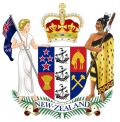Gisborne
New Zealand heraldry portal
This page is part of the New Zealand heraldry portal |
Heraldry of the World |
|
Civic heraldry:
|
Other heraldry: |
GISBORNE
Region: Gisborne
| English | blazon wanted |
===Origin/meaning===A committee of four residents submitted the design to the Chester Herald of the College of Arms in 1967 with Council subsequently registering the product with the College of Heralds in England. Gisborne City's Coat of Arms is unique in that the idea and development came from residents rather than the municipal body, and it has the only 'Compartment' derived from traditional Maori ethnic design.
The pall, or inverted 'Y' signifies the Taruheru and Waimata rivers conjoining into the Turanganui River which flows out to the sea, represented by the chief wavy. On the Chief is the "Endeavour" to note the first landing on New Zealand by Captain James Cook on Oct 9th 1769.
The bulls' heads represent the agricultural aspects of the eastern districts, while the mitre signifies the coming of Christianity to the East Coast through Bishop Williams and his descendants.The Crest displays a sunburst enclosing Mount Hikurangi and is significant of the fact that on the true meridian, the mountain and East Cape are the first major land points on which the rising sun shines.
The Lions, as supporters, are included from the Family Arms of the Hon. William Gisborne, MLC after whom the city was named. In fact the ermine sable lion (left) is of this family and the golden lion is included for balance. The forked tail of the sable lion represents the main highways north and south from the city while the single tail of the golden lion represents the East Coast scenic highway to Opotiki. Dovetailed collars in reverse colours on the lions symbolise the fusion of and harmony between Maori and Pakeha.
The compartment is a unique departure in Heraldry, being totally in a Maori expression. It represents the Maori people as the original inhabitants of New Zealand and the 'base' on which the area's achievement' is built. The Koruru head, in Maori Carving, is the "keeper of the House" and is placed at the apex of the entrance gable of every Meeting House. The Takitimu and Horouta canoes, according to Maori legend were those which landed on the East Coast at the time of the great migration and from which landed the ancestors of the present tribes in residence.
The motto although unregistered is "Endeavour" and refers both to the aspirations of the area and to the first European landing.
Contact and Support
Partners:
Your logo here ?
Contact us
© since 1995, Heraldry of the World, Ralf Hartemink 
Index of the site
Literature : Information obtained from Lawrence Jones












